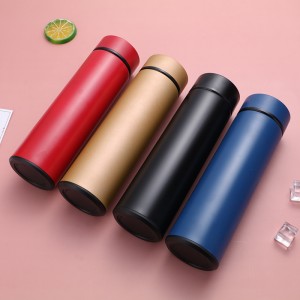“Give me a thermos when it’s cold and I can soak up the whole world.”
A thermos cup, just looking good is not enough
For health-preserving people, the best partner of the thermos cup is no longer the “unique” wolfberry. It can also be used to make tea, dates, ginseng, coffee… However, a recent survey found that some thermos cups on the market have substandard fillings. Good quality issue. What? Quality problem? Is the insulation effect worse? NO! NO! NO! The insulation is almost tolerable, but if heavy metals exceed the standard, the problem will be big!
Appearance is the basic “responsibility” of a thermos cup, but when you hold it in the palm of your hand, you will find that the material is more important than appearance.

Most thermos cups are made of stainless steel, which is high temperature resistant and has good heat preservation performance. Other materials such as glass, ceramics, purple sand, etc. are only a small part of the army of thermos cups due to factors such as thermal insulation, anti-fall, and price.
Stainless steel materials are usually divided into three types, and the “code names” are 201, 304 and 316.
201 stainless steel, “Li Gui” who is good at disguise
Most of the substandard thermos cups exposed in the news use 201 stainless steel as the liner of the thermos cup. 201 stainless steel has high manganese content and poor corrosion resistance. If it is used as the liner of a thermos cup, storing acidic substances for a long time may cause manganese elements to precipitate. Metal manganese is an essential trace element for the human body, but excessive intake of manganese can harm the body, especially the nervous system. Imagine if your children were allowed to drink this water all day long, the consequences would be really serious!
304 stainless steel, the real material is very “resistant”
When stainless steel comes into contact with food, the safety hazard is mainly the migration of heavy metals. Therefore, stainless steel materials in contact with food must be food grade. The most commonly used food-grade stainless steel is 304 stainless steel with better corrosion resistance. To be named 304, it needs to contain 18% chromium and 8% nickel to be justified. However, merchants will mark stainless steel products with the word 304 in a prominent position, but marking 304 does not mean that it meets the requirements for food contact use.
316 stainless steel, aristocratic origin is not stained by the “mundane world”
304 stainless steel is relatively acid-resistant, but it is still prone to pitting corrosion when encountering substances containing chloride ions, such as salt solutions. And 316 stainless steel is an advanced version: it adds metal molybdenum on the basis of 304 stainless steel, so that it has better corrosion resistance and is more “resistant”. Unfortunately, the cost of 316 stainless steel is relatively high, and it is mostly used in high-precision fields such as medical and chemical industries.
// There are hidden dangers, soaking in things that shouldn’t be soaked
A thermos cup is a thermos cup, so you can just soak the wolfberry in it. Of course, you can’t soak it in the whole world! Not only that, some common things in daily life cannot be soaked in a thermos cup.
1
Tea
Making tea in a stainless steel thermos cup will not cause metal chromium migration, nor will it cause corrosion to the stainless steel material itself. But even so, it is not recommended to use a thermos cup to make tea. This is because tea is usually suitable for brewing. Long-term hot water soaking will destroy the vitamins in the tea and reduce the flavor and taste of the tea. Moreover, if the cleaning is not timely and thorough after making tea, tea scale will adhere to the inner tank of the thermos cup, causing odor.
2
Carbonated drinks and juices
Carbonated drinks, fruit juices, and some traditional Chinese medicines are mostly acidic and will not cause heavy metal migration if placed in a thermos cup for a short period of time. However, the composition of these liquids is complex, and some are highly acidic. Long-term contact may corrode stainless steel, and heavy metals may migrate into the drink. When using a thermos cup to hold gas-producing liquids such as carbonated drinks, be careful not to overfill or overfill the cup, and avoid violent shaking to prevent dissolved gas from escaping. A sudden increase in pressure in the cup will also cause safety hazards.
3
Milk and soy milk
Milk and soy milk are both high-protein drinks and are prone to spoilage if kept warm for a long time. If you drink milk and soy milk that have been stored in a thermos cup for a long time, it will be difficult to avoid diarrhea! In addition, the protein in milk and soy milk can easily adhere to the wall of the cup, making cleaning difficult. If you only use a thermos cup to hold milk and soy milk temporarily, you should first use hot water to sterilize the thermos cup, drink it as soon as possible, and clean it as soon as possible. Try to be “gentle” when cleaning, and avoid using hard brushes or steel balls to prevent scratching the stainless steel surface and affecting corrosion resistance.
// Tips: Choose your thermos cup like this
First, purchase through formal channels and try to choose products from well-known brands. When purchasing, consumers should pay attention to check whether the instructions, labels and product certificates are complete, and avoid purchasing “three-no products”.
Second, check whether the product is marked with its material type and material composition, such as austenitic SUS304 stainless steel, SUS316 stainless steel or “stainless steel 06Cr19Ni10″.
Third, open the thermos cup and smell it. If it is a qualified product, because the materials used are all food grade, there will generally be no odor.
Fourth, touch the cup mouth and liner with your hands. The liner of a qualified thermos cup is relatively smooth, while most inferior thermos cups feel rough to the touch due to material problems.
Fifth, sealing rings, straws and other accessories that are easily in contact with liquids should use food-grade silicone.
Sixth, water leakage and thermal insulation performance tests should be carried out after purchase. Usually the thermal insulation time needs to be more than 6 hours.
Post time: Mar-15-2024


